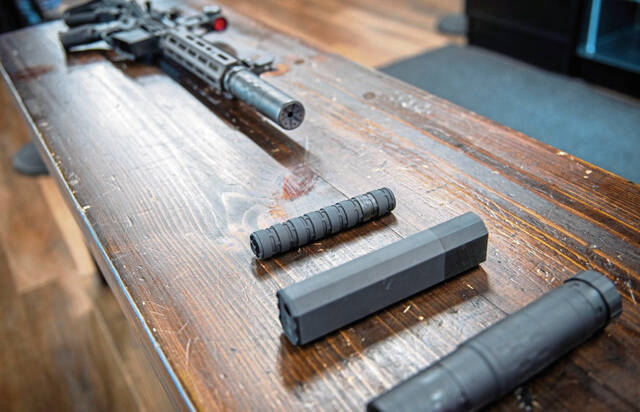Elimination of a $200 tax could transform nation’s gun regulations
A seemingly small change to a federal law that has regulated some firearms for more than 80 years could be an open door for lawsuits with the potential to transform gun regulations.
Part of President Donald Trump’s “Big Beautiful Bill” rolls back to zero a federal excise tax on certain items regulated by the federal Bureau of Alcohol, Tobacco, Firearms and Explosives. Specifically, the law eliminates the $200 federal tax on the purchase of short-barreled rifles and shotguns and so-called “silencers” beginning Jan. 1.
Guns, other than pistols, are considered to be “short-barreled” if their barrels are less than 16 inches long. Silencers, legally referred to as “suppressors,” are attached to the barrel of a gun and reduce the decibel level of gunshots, making them quieter but not silent.
Gun rights groups, including Gun Owners of America, have filed suit claiming the elimination of the tax draws into question the legality of the entire National Firearms Act. They argue that the items soon to be without the special tax should be removed from the law completely.
The National Firearms Act is a 1934 law that places restrictions on certain firearms and accessories like machine guns, short-barreled rifles and shotguns, silencers and destructive devices such as grenades and missiles. It also regulates “any other weapons,” a category that consists of firearms like those disguised as canes or pens as well as certain types of AR-style pistols.
Although it doesn’t bar individuals from owning those weapons, the firearms act sets a rigorous process for obtaining them. That includes an extensive background check beyond those used when purchasing more traditional firearms; photographing; fingerprinting; approval from the Bureau of Alcohol, Tobacco, Firearms and Explosives; and, until January, a $200 excise tax.
Though congressional Republicans had sought greater modifications to the act, the only substantive change to make it into the bill was the elimination of the $200 tax. All of the other regulations to own an item covered by the law will remain.
The National Firearms Act was enacted in response to 1930s gangland violence with the intent to regulate weapons and parts associated with guns used by organized crime members, like Tommy Guns and silencers, according to Robert Spitzer. Spitzer taught at the State University of New York at Cortland for more than 40 years and has authored several books about guns, among them “Guns Across America: Reconciling Gun Rules And Rights” and “The Politics of Gun Control.”
The firearms act generally has had its intended effect — keeping more dangerous firearms away from criminals, Spitzer said.
The $200 tax, he said, was a serious deterrent to the purchase of items covered under the act when the law was passed in the 1930s, but the tax was never increased and is a smaller obstacle today. Gun Owners of America says the tax, when first passed, was the equivalent of almost $5,000 in today’s dollars.
The firearms act was challenged but upheld by the Supreme Court soon after its passage, Spitzer said. Among the challenges was a 1937 case in which the court ruled that the act was legal under Congress’ power to levy taxes.
But the elimination of the excise tax, Gun Owners of America spokesman Luis Valdes said, again calls into question the legality of the act.
“The fact that now there is no tax being collected, that means the (firearms act) is in violation of the Second Amendment even according to that 1937 case,” Valdes said.
The ultimate goal of his organization, Valdes said, is the elimination of the act.
The Big Beautiful Bill’s change essentially served as a vehicle for the lawsuit filed by Gun Owners of America, said David Pucino, legal director at the gun control advocacy group Giffords.
The lawsuit is the latest in a long-running effort by Gun Owners of America and like-minded groups to undermine the National Firearms Act, Pucino said.
“Right now, the targets are silencers, short-barreled rifles, short-barreled shotguns, but the next step is machine guns,” he said. “It’s a clear progression.”
To respond to the suit, Pucino said, Giffords is “considering every option.” That could include responding in court as well as rallying state governments to impose their own restrictions, he said. Some states, including Pennsylvania, have state laws that prohibit the ownership of items like gun suppressors that cannot be enforced because Congress claimed federal jurisdiction over the items.
Both sides seem to agree on one point: The changes in the Big Beautiful Bill are only the first step in a process that could transform the nation’s firearms regulations.
“This step here is a dangerous one, but it’s just an opening chapter, an opening salvo for their eventual goals,” Pucino said.
As for Valdes, he said he doesn’t expect what he termed the Gun Owners of America’s “One Big Beautiful Lawsuit” to run into many obstacles, saying the organization’s argument is simple: If Congress can’t tax it, it can’t regulate it.
“It’s a small step in the right direction, and we’re going to keep marching to total victory,” he said.
James Engel is a TribLive staff writer. He can be reached at jengel@triblive.com
Remove the ads from your TribLIVE reading experience but still support the journalists who create the content with TribLIVE Ad-Free.



